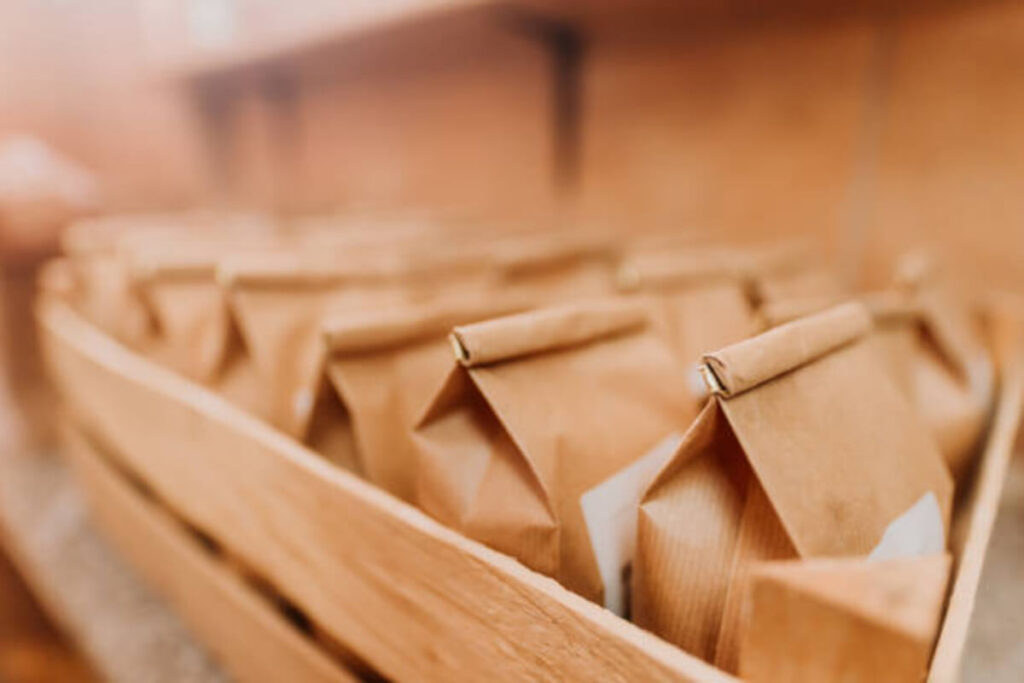Paper bags are a type of container made of paper or paperboard. They are commonly used for carrying groceries, clothing, gifts, and other items.
Paper bags can be made from different types of paper, including Kraft paper, recycled paper, and specialty paper. They can also vary in size, shape, and style. For example, some paper bags have handles, while others are designed to be carried like a briefcase.
One advantage of paper bags is that they are recyclable and biodegradable, which makes them an eco-friendly alternative to plastic bags. However, the production of paper bags does require the cutting down of trees and the use of energy and water in the manufacturing process.
Paper bags have a long history, with the first patent for a machine to make them granted in 1852. They have since become a staple in many industries and are widely used by retailers, restaurants, and other businesses around the world.
Also, check out the Types and Prices of Industrial Sewing Machines.
Paper bags come in various sizes, from small ones that can fit a single item to larger ones that can hold multiple items. They are often used as a more sustainable alternative to plastic bags, which can have a significant impact on the environment.
Paper bags are also commonly used for packaging food products, such as bakery items, snacks, and fast food. They are typically coated with a thin layer of wax or plastic to prevent the contents from leaking or getting soggy.
Another advantage of paper bags is that they can be easily customized with logos, designs, or text, making them a popular choice for branding and marketing purposes. They can also be printed with instructions, nutritional information, or promotional messages.
Some paper bags are designed with special features, such as reinforced bottoms or side gussets, to increase their strength and durability. Others are made with handles, either twisted paper or rope handles, for easier carrying.
Overall, paper bags are a versatile and environmentally-friendly packaging option that can be used in a variety of settings.
How are paper bags made?
Paper bags are typically made by a process called “tube making” and “bottoming.” Here are the basic steps in the process:
- Paper rolls: The process starts with large rolls of paper, typically made of kraft paper, which is a strong, durable paper material.
- Printing and cutting: The paper is printed with any desired design, text, or branding. The paper is then cut to the desired size for the bags.
- Tube making: The paper is fed into a machine that forms it into a tube shape. The tube is then folded and glued to create a seam along the edge.
- Bottoming: The bottom of the tube is then folded and glued to create a flat surface. This can be done by either a machine or by hand.
- Handles: If the bag is designed to have handles, these are added at this stage. Handles can be made of twisted paper, rope, or other materials.
- Finishing touches: Any final touches, such as adding a wax or plastic coating, are done to finish the bag.
Once the bags are finished, they can be bundled and packaged for distribution to stores or other businesses.
The benefits of paper bags
There are several benefits of using paper bags over other types of bags, such as plastic bags:
Environmentally friendly
One of the most significant advantages of paper bags is that they are made from renewable resources, such as wood pulp, and are biodegradable and recyclable.
This means that they have a lower environmental impact compared to plastic bags, which are made from non-renewable fossil fuels and can take hundreds of years to decompose.
Versatile
Paper bags are available in a variety of sizes and shapes, making them suitable for different types of products, from small items like jewelry and cosmetics to larger items like clothing and groceries.
Customizable
Paper bags can be printed with customized designs, logos, and other branding elements, making them an effective marketing tool for businesses.
Durable
Paper bags are strong and durable, especially when made with high-quality paper and reinforced with handles and other features.
Cost-effective
Compared to other types of bags, paper bags are often cost-effective, especially when purchased in bulk.
Healthier
Some studies have shown that using paper bags for food packaging may be healthier than using plastic bags, as paper bags are less likely to contain harmful chemicals that can leach into food.
Overall, paper bags are a versatile, customizable, and eco-friendly packaging option that can benefit both businesses and the environment.
The drawbacks of paper bags
While paper bags have many benefits, there are also some drawbacks to consider:
Durability
While paper bags are generally strong and durable, they are not as durable as plastic bags, especially when exposed to moisture or heavy items. This means that they may not be suitable for long-term use or for carrying heavy items.
Production and transportation
The production and transportation of paper bags can have a significant environmental impact, as it requires the use of energy and water, and can result in greenhouse gas emissions and other pollutants.
Recycling challenges
While paper bags are recyclable, the recycling process can be more complicated than for other materials. For example, paper bags that have been contaminated with food waste or other substances may not be recyclable and may need to be thrown away.
Deforestation
The production of paper bags requires the use of wood pulp, which can contribute to deforestation and habitat loss if not managed sustainably.
Cost
While paper bags can be cost-effective when purchased in bulk, they may be more expensive than plastic bags when purchased individually or in small quantities.
Overall, while paper bags have many benefits, it is important to consider their drawbacks and use them responsibly to minimize their environmental impact. This can include using them only when necessary, recycling them properly, and choosing paper bags that are made from sustainably sourced materials.
Also, check out DNA Testing Facilities in Lagos.
Are paper bags recyclable?
Yes, paper bags are generally recyclable. In fact, they are one of the most commonly recycled materials. Recycling paper bags helps to reduce the amount of waste in landfills, conserve resources, and reduce greenhouse gas emissions.
When recycling paper bags, it’s important to make sure that they are clean and free of any food or other contaminants, as this can make them more difficult to recycle. It’s also important to check with your local recycling program to see if they accept paper bags, as not all recycling programs accept all types of materials.
In addition to recycling, paper bags can also be reused in a variety of ways, such as for wrapping gifts or carrying small items. When using paper bags for multiple purposes, it’s important to make sure that they are still in good condition and free of any tears or holes, as this can reduce their strength and durability.
Overall, recycling and reusing paper bags can help to reduce waste, conserve resources, and support a more sustainable future.
How to store and reuse paper bags
Storing and reusing paper bags is a great way to reduce waste and save money. Here are some tips on how to store and reuse paper bags:
Store them in a dry place
Paper bags should be stored in a dry place to prevent them from getting damp or developing mold. A clean, dry pantry or closet is a good place to store them.
Flatten them
Flattening paper bags before storing them can help to save space and make them easier to store. Simply fold the bag in half lengthwise, then fold it in half again, and continue folding until it’s the desired size.
Use them for storage
Paper bags can be used to store a variety of items, from pantry staples like potatoes and onions to craft supplies or small toys. Simply fold the top of the bag down to create a seal and label the bag with the contents.
Reuse them for shopping
Paper bags can be reused for grocery shopping or other errands. Simply fold the bag flat and keep it in your car or purse for the next time you need it.
Use them for crafts
Paper bags can be used for a variety of craft projects, from making puppets and masks to creating gift bags or wrapping paper. Get creative and see what you can come up with!
By storing and reusing paper bags, you can help to reduce waste and support a more sustainable lifestyle.
Final Notes on Paper Bags
In conclusion, paper bags are an environmentally friendly alternative to plastic bags that offer a range of benefits, including being renewable, recyclable, versatile, customizable, durable, and cost-effective.
However, it is important to consider their drawbacks, such as their lower durability compared to plastic bags, the environmental impact of their production and transportation, the challenges of recycling them, and the potential for contributing to deforestation.
By using paper bags responsibly, storing and reusing them, and recycling them properly, we can help to reduce waste, conserve resources, and support a more sustainable future.







